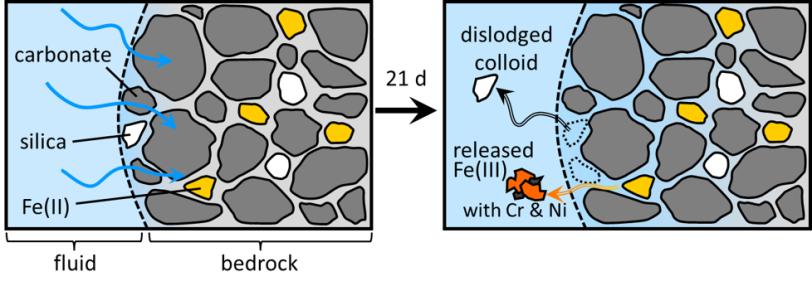Environmental Impact of Solution pH on the Formation and Migration of Iron Colloids in Deep Subsurface Energy Systems
By Spielman-Sun, E.; Bland, G.; Wielinski, J.; Frouté, L.; Kovscek, A. R.; Lowry, G. V.; Bargar, J. R.; Noël, V.

The Science
Numerous subsurface processes can promote fluid-rock interactions that can lead to the formation of small colloidal particles that are suspected to migrate through the rock matrix and promote the mobilization of nutrients and/or contaminants. To study this, two different carbonate-rich shales were exposed to different solution pHs (pH=2 and 7). Iron and other mineral transformations at the shale-fluid interface along with the generated colloids in the bulk fluid were characterized by a suite of laboratory and synchrotron-based techniques. Iron-(oxyhydr)oxide colloids colocated with silicates were observed at the fluid-shale interfaces from the pH=2 exposure, and iron EXAFS spectra of the solution at the shale-fluid interface suggests the rapid (within minutes) formation of ferrihydrite-like colloids. Regardless of pH, the mobilization of chromium and nickel with these iron colloids into the bulk fluid was detected.
The Impact
Overall, this study demonstrates that oxygenated water filtration can promote the mobilization of existing silicate minerals and the formation of new iron colloids from bedrock. These generated colloids have the potential to move through the subsurface, subsequently mobilizing other nutrients and contaminants, and thus are important for understanding of the fate and transport of colloids in the subsurface.
Summary
The goal of this work was to understand the geochemical changes of the shale bedrock in response to oxygenated water filtration, at acidic and neutral pH, that can promote the formation and migration of colloids. Two different carbonate-rich shales were exposed to different solution pHs (acidic and neutral). Regardless of pH, Fe(III)-(oxyhydr)oxide colloids were observed to be collocated with silicates and with trace metals such as Cr and Ni, which demonstrates that these particles are capable of mobilizing nutrients and contaminants. By gaining a deeper understanding of the parameters that promote the generation and migration of colloids such as those observed in this study, researchers can develop strategies to enhance containment and mitigate the risk of environmental contamination.
Contacts
Vincent Noël
SLAC National Accelerator Laboratory, Stanford Synchrotron Radiation Lightsource
noel@slac.stanford.edu
Eleanor Spielman-Sun
SLAC National Accelerator Laboratory, Stanford Synchrotron Radiation Lightsource
espielma@stanford.edu
Funding
This work was supported as part of the Center for Mechanistic Control of Water-Hydrocarbon-Rock Interactions in Unconventional and Tight Oil Formations (CMC-UF), an Energy Frontier Research Center funded by the U.S. Department of Energy (DOE), Office of Science under DOE (BES) Award DE-SC0019165 (shale samples, materials, exposure experiments). Additional funding was provided by the SLAC Floodplain Hydro-Biogeochemistry SFA program of the U.S. DOE, Office of Biological and Environmental Research, Earth and Environmental Systems Sciences Division under DOE Contract No. DE-AC02-76SF00515 (data analysis and writing). Funding for J.W. for the sp-icpTOF-MS work was provided by the Swiss National Science Foundation under the Postdoc Mobility program (Project No. P500N_202844). Use of the Stanford Synchrotron Radiation Lightsource (Beamlines 2-3, 6-2, and 7-3), SLAC National Accelerator Laboratory for synchrotron-based experiments is supported by the U.S. DOE, Office of Science, Office of Basic Energy Sciences under Contract No. DE-AC02-76SF00515. We thank the following beamline scientists for help with these synchrotron-based characterization studies: Drs. Samuel Webb, Sharon Bone, Leah Kelly, and Matthew Latimer. We also thank Dr. Juan Salvador Lezama Pacheco for his help with the shell-by-shell fits. XRD, bulk XRF, and ICP-MS data were collected at the Environmental Measurements Facility (EMF) at the Stanford School of Earth, Energy, and Environmental Sciences. SEM images were collected at the Stanford Nano Shared Facilities (SNSF), which is supported by the National Science Foundation under Award ECCS-2026822.
Publications
Spielman-Sun, E.; Bland, G.; Wielinski, J.; Frouté, L.; Kovscek, A. R.; Lowry, G. V.; Bargar, J. R.; Noël, V. (2023) Environmental impact of solution pH on the formation and migration of iron colloids in deep subsurface energy systems. Sci Total Environ https://doi.org/10.1016/j.scitotenv.2023.166409
